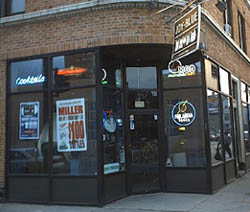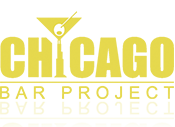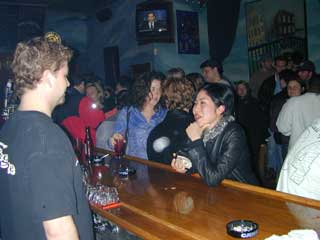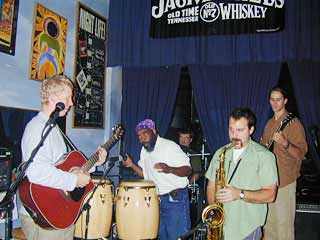Editor’s Note: Ala Prodigal Son, Joy Blue closed due to a fire and has been replace by a lighting store, of all things.
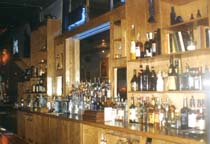 Joy Blue was one of the first establishments to help transform the stretch of Irving Park Road, between Southport and Western, into a more happening nightlife district. Joy Blue offers a loungey oasis where patrons can enjoy mixed drinks, a funky atmosphere, eclectic furnishings, live music, and even slam poetry on Wednesday nights. Joy Blue can be a great place to go after a show at the Music Box or Mercury Theater, located a few blocks south on Southport, or after dinner at one of the area’s coolest restaurants of which Tango Sur, Cullen’s and Deleece stand out. Joy Blue is also hopping on the weekends where you will either find a DJ or live music. Whatever day of the week, it’s hard to go wrong at Joy Blue if you’re in the mood for cocktails, which is a far cry from its former days as Austin City Limits and Irv’s Tap.
Joy Blue was one of the first establishments to help transform the stretch of Irving Park Road, between Southport and Western, into a more happening nightlife district. Joy Blue offers a loungey oasis where patrons can enjoy mixed drinks, a funky atmosphere, eclectic furnishings, live music, and even slam poetry on Wednesday nights. Joy Blue can be a great place to go after a show at the Music Box or Mercury Theater, located a few blocks south on Southport, or after dinner at one of the area’s coolest restaurants of which Tango Sur, Cullen’s and Deleece stand out. Joy Blue is also hopping on the weekends where you will either find a DJ or live music. Whatever day of the week, it’s hard to go wrong at Joy Blue if you’re in the mood for cocktails, which is a far cry from its former days as Austin City Limits and Irv’s Tap.
 Joy Blue is located on the southwest corner of Irving Park Road and Southport Avenue. To find it, just look for the the blue neon “Cocktails” and Finlandia Vodka signs in the window, and the simple wooden sign with the smiling white laundry faces and the sad blue shirt face hanging above the door (maybe they’ll speak to you if you have enough to drink). Joy Blue doesn’t look like much from the outside with its dark glass-paneled façade, housed in a nice but plain tan brick building. However, do not let looks deceive you as inside is quite another story. The main bar area features a long, wooden L-shaped bar that runs along the east side of the room and which terminates at the DJ booth in front of the large wood and glass wall cooler at the south end of the room. The DJ is oft heard pumping out loud alternative dance music that seems to be a catalyst for vodka consumption. The cooler holds a selection of over 100 bottled beers to choose from, including such curiosities as Flying Dog Pale Ale, H.C. Burger Chocolate Stout, and Kwias Cream Ale (which is sold for $100 a bottle). Joy Blue also has a good selection of red and white wines, and even a few bottles of port. Patrons can also enjoy the house’s signature “Blue Joy” shot, which consists of closely-guarded, secret ingredients. In the southeast corner of the room hangs a paper-mâché hammerhead shark, reminiscent of the stuffed one at nearby Toons. Behind the bar stands a tall wooden shelving unit that holds copious amounts of booze, blue lights, some books, a few statues, and a selection of nine premium cigars.
Joy Blue is located on the southwest corner of Irving Park Road and Southport Avenue. To find it, just look for the the blue neon “Cocktails” and Finlandia Vodka signs in the window, and the simple wooden sign with the smiling white laundry faces and the sad blue shirt face hanging above the door (maybe they’ll speak to you if you have enough to drink). Joy Blue doesn’t look like much from the outside with its dark glass-paneled façade, housed in a nice but plain tan brick building. However, do not let looks deceive you as inside is quite another story. The main bar area features a long, wooden L-shaped bar that runs along the east side of the room and which terminates at the DJ booth in front of the large wood and glass wall cooler at the south end of the room. The DJ is oft heard pumping out loud alternative dance music that seems to be a catalyst for vodka consumption. The cooler holds a selection of over 100 bottled beers to choose from, including such curiosities as Flying Dog Pale Ale, H.C. Burger Chocolate Stout, and Kwias Cream Ale (which is sold for $100 a bottle). Joy Blue also has a good selection of red and white wines, and even a few bottles of port. Patrons can also enjoy the house’s signature “Blue Joy” shot, which consists of closely-guarded, secret ingredients. In the southeast corner of the room hangs a paper-mâché hammerhead shark, reminiscent of the stuffed one at nearby Toons. Behind the bar stands a tall wooden shelving unit that holds copious amounts of booze, blue lights, some books, a few statues, and a selection of nine premium cigars.
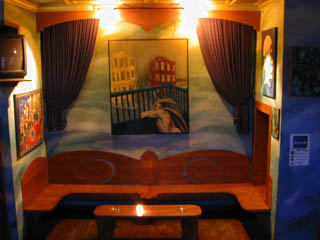 The north end of the room features a few cocktail tables lit with white votive candles, located across from the mini-ATM. Here, between the blue drapes, you can pass the time by observing the passersby on Irving Park. Bands occasionally play at night and, when they do, these tables are moved out of the way to make room for them. A $3 cover either for the band or the DJ is charged on the weekends. The west wall of the room is lined with a long wooden railing with mirrors and stools beneath it, a giant puffer fish hanging from the dark tin ceiling above it, and is painted like the blue sky with wispy white clouds. This mural compliments the giant Dali / Escher / Van Gogh-like mural across from it. Also located along the west wall is a nook where patrons can observe the throng from wooden benches. This nook also features maroon drapes, a few paintings by local artists, and a wooden coffee table for your drinks (not your feet, Chief). If you want to hang out with your friends in the alcove seating area, all I can say is: get there early. The effect of the room rivals other trendy locales, such as the Tiny Lounge, Get Me High Lounge and Danny’s Tavern. The only detractor to the ambiance is the stubborn prevalence of guys with baseball hats bumping into the nicely dressed crowd while playing Golden Tee on one of the two machines. I feel bad for these guys as they miss out on the interesting scene surrounding them. The bar also has three televisions, but they are often turned off or merely blend into the background.
The north end of the room features a few cocktail tables lit with white votive candles, located across from the mini-ATM. Here, between the blue drapes, you can pass the time by observing the passersby on Irving Park. Bands occasionally play at night and, when they do, these tables are moved out of the way to make room for them. A $3 cover either for the band or the DJ is charged on the weekends. The west wall of the room is lined with a long wooden railing with mirrors and stools beneath it, a giant puffer fish hanging from the dark tin ceiling above it, and is painted like the blue sky with wispy white clouds. This mural compliments the giant Dali / Escher / Van Gogh-like mural across from it. Also located along the west wall is a nook where patrons can observe the throng from wooden benches. This nook also features maroon drapes, a few paintings by local artists, and a wooden coffee table for your drinks (not your feet, Chief). If you want to hang out with your friends in the alcove seating area, all I can say is: get there early. The effect of the room rivals other trendy locales, such as the Tiny Lounge, Get Me High Lounge and Danny’s Tavern. The only detractor to the ambiance is the stubborn prevalence of guys with baseball hats bumping into the nicely dressed crowd while playing Golden Tee on one of the two machines. I feel bad for these guys as they miss out on the interesting scene surrounding them. The bar also has three televisions, but they are often turned off or merely blend into the background.
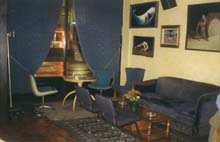 The second room, known as “The Lounge,” features a curving steel martini bar and chrome barstools. This new bar replaces its worn wooden predecessor. The rest of the room is painted in blue and beige and features a blue couch, a blue throw rug, a smattering of loungey chairs, and more blue drapes frame the front windows. The present décor replaces the pool table, large wooden benches, old antique couch, red wallpaper and particleboard, and the black drop ceiling. The third room, known as “The Blue Room,” features a slightly elevated stage at the north end lit with tiny blue lights and decorated with more blue drapes at the front windows. The room also features worn, red-painted wooden floors, and pop art photography along the west wall, framed in metal and lined with tiny white lights. The photography replaces a floor-to-ceiling mural of Jack the Ripper. High-backed leather chairs are located by the rectangular bar portal, and a black banquette, ottoman-like seating and small tables have replaced the 50’s-style upholstered chairs and couches. While most of the walls are painted in blue, part of the east wall consists of green particle board and lime green paint. These two room are also available for private parties of up to 300 people.
The second room, known as “The Lounge,” features a curving steel martini bar and chrome barstools. This new bar replaces its worn wooden predecessor. The rest of the room is painted in blue and beige and features a blue couch, a blue throw rug, a smattering of loungey chairs, and more blue drapes frame the front windows. The present décor replaces the pool table, large wooden benches, old antique couch, red wallpaper and particleboard, and the black drop ceiling. The third room, known as “The Blue Room,” features a slightly elevated stage at the north end lit with tiny blue lights and decorated with more blue drapes at the front windows. The room also features worn, red-painted wooden floors, and pop art photography along the west wall, framed in metal and lined with tiny white lights. The photography replaces a floor-to-ceiling mural of Jack the Ripper. High-backed leather chairs are located by the rectangular bar portal, and a black banquette, ottoman-like seating and small tables have replaced the 50’s-style upholstered chairs and couches. While most of the walls are painted in blue, part of the east wall consists of green particle board and lime green paint. These two room are also available for private parties of up to 300 people.
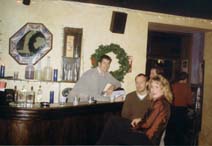
Old bar in “The Lounge”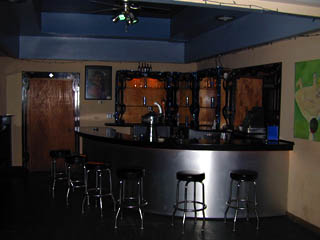
New bar in “The Lounge”
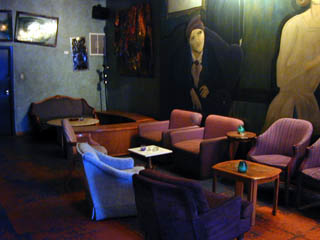 The whole effect of “The Blue Room” is a perfect match for the poetry slam on Wednesday nights. “We should be famous,” comments Lisa Hemminger, the host of the poetry slam on one of these nights. That night featured some excellent poetry, but also some poets who demanded acceptance while falling back on stereotypes in the same manner as they accuse others of doing. In addition, one of the poets was holding a fundraiser so that other people could pay for her to move into a new apartment. Unfortunately, instead of being open to patrons wandering in from one of the other two rooms, the group I encountered seemed quite inwardly-focused and unaccepting to newcomers. I think it may be more fitting for this group to host their slams in a basement somewhere and free up the room for more productive uses. If you want quality slam poetry, head to the Green Mill on Sunday nights or Weeds Tavern on Monday nights. Sundays at Joy Blue feature an open mic, and Mondays feature live jazz.
The whole effect of “The Blue Room” is a perfect match for the poetry slam on Wednesday nights. “We should be famous,” comments Lisa Hemminger, the host of the poetry slam on one of these nights. That night featured some excellent poetry, but also some poets who demanded acceptance while falling back on stereotypes in the same manner as they accuse others of doing. In addition, one of the poets was holding a fundraiser so that other people could pay for her to move into a new apartment. Unfortunately, instead of being open to patrons wandering in from one of the other two rooms, the group I encountered seemed quite inwardly-focused and unaccepting to newcomers. I think it may be more fitting for this group to host their slams in a basement somewhere and free up the room for more productive uses. If you want quality slam poetry, head to the Green Mill on Sunday nights or Weeds Tavern on Monday nights. Sundays at Joy Blue feature an open mic, and Mondays feature live jazz.

Old “Blue Room” furnishings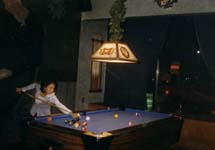
Adios, Mr. Pool Table
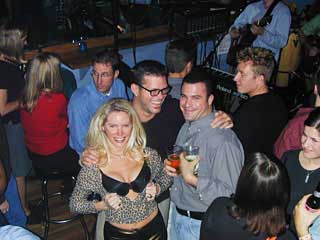 Before it was Joy Blue, the bar was known as Austin City Limits, not to be confused with the PBS show of the same name. Both the bar and the Mexican restaurant next door, known as La Vallita, were owned by the same proprietor. According to the Official Chicago Bar Guide (1995), Austin City Limits was described as, “A quiet corner bar that belies the promise of its name. Laid-back neighborhood crowd. Downscale.” When the owner decided to retire and sell the bar, owners Mark Kwiatkowski, Chris Krubert and Christian Sikorski picked it up in 1996 and renovated it into its present-day swankiness. Now, blues, jazz and R&B has replaced country music on the jukebox. I consider this a victory for good taste. While it initially was more of an extension of the popular Southport corridor to the south, Joy Blue has helped rejuvenate this relatively unknown section of Lakeview – especially now that newcomers like the Long Room, Lyons Den and O’Donovan’s to the west have also opened their doors for business.
Before it was Joy Blue, the bar was known as Austin City Limits, not to be confused with the PBS show of the same name. Both the bar and the Mexican restaurant next door, known as La Vallita, were owned by the same proprietor. According to the Official Chicago Bar Guide (1995), Austin City Limits was described as, “A quiet corner bar that belies the promise of its name. Laid-back neighborhood crowd. Downscale.” When the owner decided to retire and sell the bar, owners Mark Kwiatkowski, Chris Krubert and Christian Sikorski picked it up in 1996 and renovated it into its present-day swankiness. Now, blues, jazz and R&B has replaced country music on the jukebox. I consider this a victory for good taste. While it initially was more of an extension of the popular Southport corridor to the south, Joy Blue has helped rejuvenate this relatively unknown section of Lakeview – especially now that newcomers like the Long Room, Lyons Den and O’Donovan’s to the west have also opened their doors for business.
Prior to Austin City Limits, Joy Blue was an odd little joint humbly called, “Irv’s Tap.” A Chicago Bar Project fan describes it thusly:
“In the early 80s I lived about a block north of this place. It was called ‘Irv’s Tap’ then, and just south was ‘Irv’s Drugstore.’ Irv was a strange neighborhood denizen. I rarely saw anyone in the drugstore. The bar itself was old and dingy and absolutely reeked of stale beer. During the summer the A/C was cranked down to maybe 65˚ to keep the stench down. I would often duck out to Irv’s Tap to get a six-pack to go. On the way out I’d get a shot of Wild Turkey, simply because it was the highest-proof hooch they had there. At the front part of Irv’s there would be a number of young Spanish men, just chilling after work and listening to Spanish tunes on the jukebox which was turned up loud. At the back of the bar was a small group of white guys in their 50s and 60s, speaking a mix of English and German. Remnants, I guess, of the former German population there. Strange mix. The bartender was a short, fat cheerful Spanish guy named Zorro. He had this interesting Sunday habit. If I went in for a six-pack on Sunday, he’d buy me a shot of Wild Turkey if I didn’t ask for one. If I DID ask for one, he’d buy me the second shot. ONLY on Sundays though. I’d asked a couple Spanish coworkers if there was some significance to Sundays and buying drinks, and they were just as baffled as I was. The place had a filthy, badly-maintained pinball game up front which was set (intentionally or not) to give away numerous free games. About every third game was free, so it made it hard to play just a ‘quick’ pinball game. A few weeks before I moved out of that ‘hood, I walked into Irv’s on a Saturday night to pick up a six-pack. At the back of the place there was a full-size Fender electric piano with this guy about 60 or 70 playing it. He was wearing a glittery red evening jacket with a little tux-type tie, and he was playing old standards. To this crowd of old German guys and young Spanish guys… one of the most incongruous things I’d ever seen in any bar.”
– Tony E. (October 14, 2003)
 Whether you’re happy or sad, Joy Blue is a great place to enjoy a cocktail, survey the local talent, and either begin or cap off an adventurous evening. I suggest checking the place out for Monday night jazz or heading there prior to late night at Nick’s Uptown on the weekend. Whatever time you go, make sure you sample their impressive beer or wine selection, or have a Cosmopolitan or martini (shaken, not stirred). And guys, try to pay more attention to the ladies and the music, rather than the Golden Tee machines. I know it may be a struggle, but you’ll thank me for it in the end. And, leave the baseball hats at home. Chill, baby, chill.
Whether you’re happy or sad, Joy Blue is a great place to enjoy a cocktail, survey the local talent, and either begin or cap off an adventurous evening. I suggest checking the place out for Monday night jazz or heading there prior to late night at Nick’s Uptown on the weekend. Whatever time you go, make sure you sample their impressive beer or wine selection, or have a Cosmopolitan or martini (shaken, not stirred). And guys, try to pay more attention to the ladies and the music, rather than the Golden Tee machines. I know it may be a struggle, but you’ll thank me for it in the end. And, leave the baseball hats at home. Chill, baby, chill.
